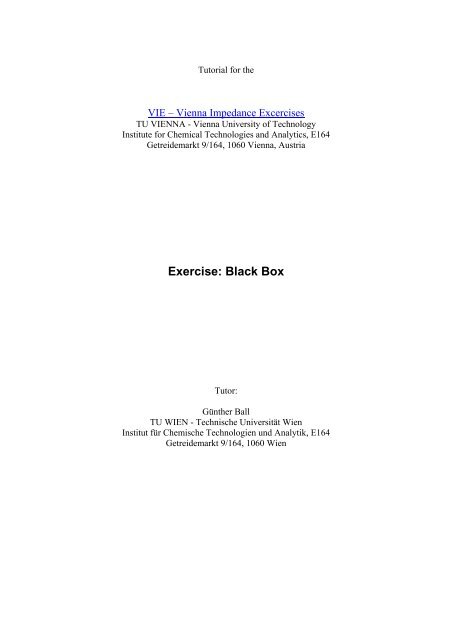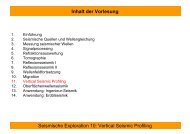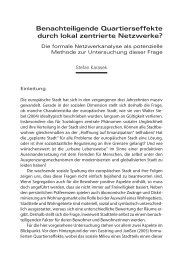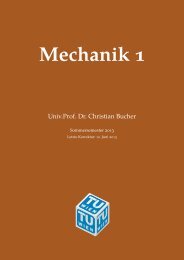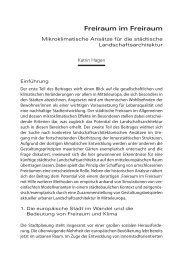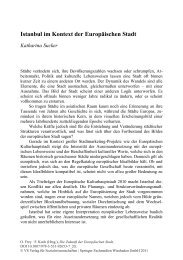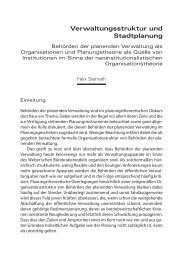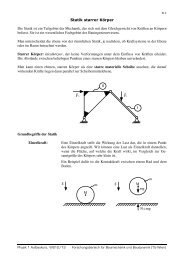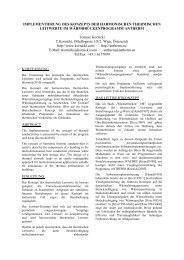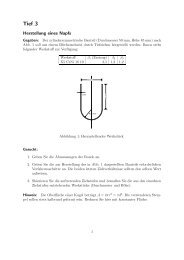Exercise: Black Box - TU Wien - Technische Universität Wien
Exercise: Black Box - TU Wien - Technische Universität Wien
Exercise: Black Box - TU Wien - Technische Universität Wien
Create successful ePaper yourself
Turn your PDF publications into a flip-book with our unique Google optimized e-Paper software.
Tutorial for the<br />
VIE – Vienna Impedance Excercises<br />
<strong>TU</strong> VIENNA - Vienna University of Technology<br />
Institute for Chemical Technologies and Analytics, E164<br />
Getreidemarkt 9/164, 1060 Vienna, Austria<br />
<strong>Exercise</strong>: <strong>Black</strong> <strong>Box</strong><br />
Tutor:<br />
Günther Ball<br />
<strong>TU</strong> WIEN - <strong>Technische</strong> <strong>Universität</strong> <strong>Wien</strong><br />
Institut für Chemische Technologien und Analytik, E164<br />
Getreidemarkt 9/164, 1060 <strong>Wien</strong>
1. Theorie<br />
1.1 Hinweise zur Darstellung von<br />
Impedanzspektren im Ortskurven- und<br />
Bode-Diagramm<br />
Um die Wahl des geeigneten Ersatzschaltbildes und<br />
die Abschätzung der Startparameterwerte für das<br />
Fitting der Daten zu erleichtern, ist es notwendig,<br />
die Achsenskalierung in den Diagrammen richtig zu<br />
wählen.<br />
Im Ortskurvendiagramm müssen die Real- (Re-)<br />
und Imaginär- (Im-) Achse nicht nur linear, sondern<br />
auch im gleichen Einheitenabstand skaliert sein,<br />
weil sich sonst typische Elemente wie ein Halbkreis<br />
eines parallelen RC-Gliedes nicht einwandfrei<br />
erkennen lassen (Abb. 1).<br />
-Im<br />
Re<br />
Bei der Darstellung im Bode-Diagramm ist es<br />
ratsam, die Frequenz- (f-) und die Impedanz- (|Z|-)<br />
Achse ebenfalls im gleichen logarithmischen<br />
Abstand zu skalieren, sodass kapazitive Bereiche<br />
des Impedanzspektrums unter einem Winkel von<br />
–45° erkennbar sind (Abb. 2).<br />
2<br />
1. Theory<br />
1.1 Advices for plotting impedance spectra<br />
in a complex plane plot and Bode plot<br />
To facilitate the choice of an appropriate<br />
equivalent electronic circuit and the estimation of<br />
the values of the starting parameters for the data<br />
fitting it is necessary to choose the right scaling of<br />
the axis in the plots.<br />
In the complex plane plot the real (Re) axis and the<br />
imaginary (Im) axis not only have to be scaled<br />
linear but the units must also have the same<br />
distance in order to properly recognize typical<br />
elements such as a semicircle of a parallel R-C<br />
connection (fig. 1).<br />
-Im<br />
Abb. 1: Richtiges Skalieren eines Ortskurvendiagramms<br />
Fig. 1: Proper scaling of a complex plane plot<br />
lg |Z|<br />
-45°<br />
Re<br />
When using the Bode plot it is advisable also to<br />
scale the frequency (f) and the impedance (|Z|) axis<br />
in the same logarithmic units so that capacitive<br />
areas of the impedance spectrum are identifiable by<br />
a declination at an angle of –45° (fig. 2).<br />
φ<br />
lg f<br />
Abb. 2: Richtiges Skalieren eines Bode-Diagramms<br />
Fig. 2: Proper scaling of a Bode plot
1.2 Leitfaden zur Erstellung eines<br />
elektrischen Ersatzschaltbildes für ein<br />
Impedanzspektrum<br />
Im Grunde genommen lassen sich elektrische<br />
Ersatzschaltbilder sowohl aus dem Ortskurven- als<br />
auch aus dem Bode-Diagramm ableiten. Der<br />
Einfachheit halber wird das im Folgenden aber nur<br />
anhand des Ortskurven-Diagramms erläutert.<br />
Widerstand<br />
Der Impedanzwert eines Widerstandes hat weder<br />
einen imaginären Anteil noch ist er frequenzabhängig.<br />
Ein einzelner Widerstand stellt im<br />
Ortskurvendiagramm einen Punkt auf der Re-Achse<br />
dar. In einer Ersatzschaltung wird damit ein Versatz<br />
oder die Ausdehnung z.B. eines Halbkreises auf der<br />
Re-Achse modelliert (siehe weiter unten).<br />
Kapazitätselement (Kondensator)<br />
Erst mit Hilfe von Kapazitätselementen kann man<br />
frequenzabhängige (negative) imaginäre Anteile an<br />
der Gesamtimpedanz modellieren. Das typische<br />
Impedanzspektrum eines einzelnen Kondensators<br />
ist eine Gerade auf der –Im-Achse, beginnend im<br />
Ursprung bei f → ∞.<br />
Serielles RC-Glied<br />
Das Impedanzspektrum eines einzelnen<br />
Kondensators wird bei Serienschaltung mit einem<br />
Widerstand auf der Re-Achse entsprechend dem<br />
Widerstandswert parallelverschoben (Abb. 3).<br />
-Im<br />
R<br />
C<br />
1.2 Guide for designing an equivalent<br />
electronic circuit for an impedance<br />
spectrum<br />
Actually equivalent electronic circuits can be<br />
derived from the complex plane plot as well as from<br />
the Bode plot. To simplify matters this will be<br />
illustrated in the following only on the basis of the<br />
complex plane plot.<br />
Resistor<br />
The impedance value of a resistor has no imaginary<br />
part and does not depend on the frequency. In the<br />
complex plane plot a single resistor appears as dot<br />
on the real axis. With a resistor a shift or the<br />
extension of a semicircle on the real axis for<br />
example is modeled (see further below).<br />
Capacitor<br />
Only with capacitors frequency dependent negative<br />
imaginary parts of the total impedance can be<br />
modeled. The typical impedance plot of a single<br />
capacitor is a straight line placed on the negative<br />
imaginary axis starting in the origin at f → ∞.<br />
Serial R-C connection<br />
R C<br />
Re<br />
R<br />
Abb. 3: Impedanzspektrum eines seriellen RC-Gliedes<br />
Fig. 3: Impedance spectrum of a serial R-C connection<br />
3<br />
In a serial R-C connection the impedance spectrum<br />
of a single capacitor is shifted in positive direction<br />
of the real axis corresponding to the value of the<br />
resistor (fig. 3).<br />
f
Paralleles RC-Glied<br />
Dagegen wird das Impedanzspektrum eines<br />
Kondensators bei Parallelschaltung eines<br />
Widerstandes zu einem Halbkreis geformt,<br />
beginnend im Ursprung bei f → ∞ und endend auf<br />
der Re-Achse bei f → 0 im Abstand des<br />
Widerstandswertes vom Ursprung (Abb. 4).<br />
Einfacher elektrochemischer Prozess<br />
-Im<br />
Die Impedanzkurve eines parallelen RC-Gliedes<br />
wird analog zu der eines Kondensators durch einen<br />
zusätzlichen Serienwiderstand Rs um dessen Betrag<br />
auf der Re-Achse verschoben und zeigt nun die bei<br />
vielen realen Messungen auftretende typische Form<br />
(Abb. 5).<br />
R<br />
C<br />
R<br />
Parallel R-C connection<br />
In contrary the impedance spectrum of a capacitor<br />
is formed to a semicircle when the resistor is<br />
connected in parallel to the capacitor. The<br />
semicircle starts in the origin at f → ∞ and ends on<br />
the real axis at f → 0. The distance between the two<br />
points is equal to the value of the resistor (fig. 4).<br />
f<br />
Re<br />
Abb. 4: Impedanzspektrum eines parallelen RC-Gliedes<br />
Fig. 4: Impedance spectrum of a parallel R-C connection<br />
Rs<br />
-Im<br />
Rs<br />
Simple electrochemical process<br />
C<br />
Rp<br />
Similar to a single capacitor the impedance curve<br />
of a parallel R-C connection is shifted by an<br />
additional serial resistor Rs in positive direction of<br />
the real axis corresponding to the value of the<br />
resistor. Thus it shows the typical shape of many<br />
real measurements (fig. 5).<br />
Abb. 5: Impedanzspektrum eines einfachen elektrochemischen Prozesses<br />
Fig. 5: Impedance spectrum of a simple electrochemical process<br />
Rp<br />
4<br />
f<br />
Re
Zwei Prozesse<br />
Treten zwei Halbkreise auf (mehr oder weniger<br />
deutlich bzw. ineinander übergehend; Abb. 6) ist<br />
das Modell des einfachen Prozesses mit einem<br />
Widerstand und einem Kapazitätselement zu<br />
erweitern, wobei von den zahlreichen<br />
Möglichkeiten hier zwei elektrochemisch<br />
bedeutsame dargestellt werden (Abb. 7).<br />
Diffusionselement<br />
-Im<br />
Ein Diffusionselement (Warburg, Reversible<br />
Boundary, Blocked Boundary) wird dann<br />
gebraucht, wenn die Impedanzkurve im<br />
Tieffrequenzbereich nicht wieder auf der Re-Achse<br />
endet, sondern einen „Fortsatz“ unter einem Winkel<br />
von 45° bildet (Abb. 8). Dieses typische Verhalten<br />
einer Warburg-Impedanz kann aber auch der<br />
beginnende Verlauf eines anderen<br />
Diffusionselementes bei f → 0 sein. (Die<br />
entsprechenden Diagramme befinden sich auf den<br />
Vortragsfolien im Anhang.)<br />
Two processes<br />
Re<br />
Re<br />
Abb. 6: Beispiele von Impedanzspektren mit zwei elektrochemischen Prozessen<br />
Fig. 6: Examples of impedance spectra with two electrochemical processes<br />
-Im<br />
If the impedance curve shows the shape of two<br />
semicircles (more or less separated or overlapping;<br />
fig. 6) the model of the simple process has to be<br />
extended with a resistor and a capacitor. From<br />
several possibilities two electrochemically relevant<br />
are shown below (fig. 7).<br />
Abb. 7: Typische Ersatzschaltbilder für zwei elektrochemische Prozesse<br />
Fig. 7: Typical equivalent electronic circuits for two electrochemical processes<br />
W<br />
Diffusion control<br />
A diffusion control (e.g. Warburg, reversible<br />
boundary or blocked boundary) has to be modeled<br />
if the impedance curve does not end on the real axis<br />
at low frequencies but shows an “appendix” at an<br />
angle of 45° (fig. 8). This typical behaviour of a<br />
Warburg impedance can also be the beginning<br />
section of an other type of diffusion control at<br />
f → 0. (The corresponding diagrams are shown on<br />
the presentation slides in the appendix.)<br />
Re<br />
Abb. 8: Typ. Ersatzschaltbild (links) und Ortskurve (rechts) für einen diffusionslimitierten Prozess<br />
Fig. 8: Typ. equivalent electronic circuit (left) and complex plane plot (right) for a diffusion controlled process<br />
5<br />
-Im
2. Versuche<br />
An 4 bis 6 in Gehäusen („<strong>Black</strong> <strong>Box</strong>es“) verpackten<br />
Schaltungen aus passiven elektronischen Bauteilen<br />
sollen 2-Elektroden-Impedanzmessungen<br />
durchgeführt werden. Verwendet wird dafür das<br />
Impedanzmesssystem FRA 1250/ECI 1286 der<br />
Firma Solartron. Eine ausführliche Erklärung der<br />
Geräte sowie eine umfassende Hilfestellung bei der<br />
Bedienung der Steuerungssoftware erfolgt an Ort<br />
und Stelle.<br />
3. Berechnungen<br />
Nach jeder Messung einer <strong>Black</strong> <strong>Box</strong> erfolgt die<br />
Auswertung der Daten in folgenden Schritten:<br />
3.1 Darstellung der Daten im Bode- und<br />
Ortskurvendiagramm<br />
→ Hinweise dazu siehe 1.1.<br />
3.2 Modellbildung — Entwicklung eines<br />
elektrischen Ersatzschaltbildes<br />
→ Leitfaden und Hinweise dazu siehe 1.2 und auf<br />
den Vortragsfolien im Anhang.<br />
3.3 Abschätzen der Startparameter für das<br />
Fitting<br />
→ Entsprechende Formeln und Diagramme<br />
befinden sich auf den Vortragsfolien im Anhang.<br />
3.4 Fitting der Daten<br />
Für das Fitting der Daten wird ein spezielles<br />
Programm verwendet. Dazu müssen die<br />
Impedanzdaten zuerst in ein für dieses Programm<br />
lesbares Format konvertiert werden (geschieht<br />
mittels eines weiteren Programmes).<br />
3.5 Beurteilung der Fitting-Ergebnisse<br />
Das Impedanzspektrum aus den errechneten<br />
Parametern wird mit dem gemessenen<br />
Impedanzspektrum im Ortskurven- und Bode-<br />
Diagramm verglichen und das Modell<br />
gegebenenfalls verbessert.<br />
6<br />
2. Experimental<br />
Two-electrode impedance measurements shall be<br />
carried out on 4 to 6 electronic circuits consisting<br />
of passive electronic components and hidden in<br />
“black boxes”. For this purpose the impedance<br />
measurement system FRA 1250/ECI 1286 of<br />
Solartron will be used.<br />
The devices will be explained in detail on the spot<br />
and a comprehensive assistance will be given to<br />
handle the control software.<br />
3. Calculations<br />
After measuring a black box the data evaluation<br />
will be done in following steps:<br />
3.1 Data plotting in a Bode plot and<br />
complex plane plot<br />
→ For advices see 1.1.<br />
3.2 Modeling — Development of an<br />
equivalent electronic circuit<br />
→ For instructions see 1.2 and presentation slides<br />
in the appendix.<br />
3.3 Estimation of the start parameters for<br />
the data fitting<br />
→ For equations and diagrams see presentation<br />
slides in the appendix.<br />
3.4 Data fitting<br />
For fitting the data a special program will be used.<br />
For this purpose the impedance data first have to<br />
be converted into a file format which is readable<br />
for this program (another program will do this).<br />
3.5 Evaluation of the fitting results<br />
The impedance spectrum gained from the<br />
calculated parameters will be compared with the<br />
measured impedance spectrum and if necessary the<br />
model will be corrected.
4 Anhang<br />
Vortragsfolien mit Diagrammen und Formeln zur<br />
Parameterschätzung für die wichtigsten Elemente<br />
bei der Modellbildung.<br />
4 Appendix<br />
Presentation slides with diagrams and equations<br />
for estimation of parameters concerning the most<br />
important elements for modeling.<br />
Characteristic elements of an equivalent electronic circuit<br />
Serial R-C connection<br />
Circuit diagram:<br />
R C<br />
Characteristic frequency:<br />
1<br />
2π<br />
RC<br />
Bode plot: Complex plane plot:<br />
C -1<br />
R<br />
lg |Z|<br />
1<br />
2π<br />
f0<br />
φ<br />
0°<br />
-45°<br />
-90°<br />
lg f<br />
f<br />
-Im<br />
0 =<br />
Characteristic elements of an equivalent electronic circuit<br />
Parallel R-C connection<br />
Circuit diagram:<br />
Bode plot: Complex plane plot:<br />
lg |Z|<br />
R<br />
C -1<br />
C<br />
R<br />
f0<br />
1<br />
2π<br />
φ<br />
0°<br />
-45°<br />
-90°<br />
lg f<br />
7<br />
45°<br />
R<br />
f0<br />
f<br />
Re<br />
Characteristic frequency:<br />
f<br />
-Im<br />
0 =<br />
45°<br />
f0<br />
1<br />
2π<br />
RC<br />
f<br />
R<br />
Re
Simple electrochemical process<br />
Circuit diagram:<br />
Characteristic frequencies:<br />
f<br />
01 =<br />
1<br />
2π<br />
R<br />
Bode plot: Complex plane plot:<br />
C -1<br />
Rs+Rp<br />
Rs<br />
Characteristic elements of an equivalent electronic circuit<br />
lg |Z|<br />
Rs<br />
1<br />
2π<br />
C<br />
Rp<br />
f01<br />
f02<br />
lg f<br />
Warburg diffusion control<br />
Symbol:<br />
φ<br />
0°<br />
p<br />
C<br />
-Im<br />
f02<br />
Rs<br />
f<br />
02<br />
=<br />
1<br />
1 1 −1<br />
2π<br />
( + ) C<br />
Rs<br />
Rp<br />
f01<br />
f<br />
Re<br />
Rs+Rp<br />
Bode plot: Complex plane plot:<br />
W -1<br />
Characteristic elements of an equivalent electronic circuit<br />
lg |Z|<br />
1<br />
2π<br />
W<br />
φ<br />
-45°<br />
lg f<br />
8<br />
-Im<br />
45°<br />
f<br />
Re
Characteristic elements of an equivalent electronic circuit<br />
Reversible boundary diffusion control<br />
Symbol:<br />
Bode plot: Complex plane plot:<br />
lg |Z|<br />
O<br />
φ<br />
0°<br />
-45°<br />
lg f<br />
Characteristic elements of an equivalent electronic circuit<br />
Blocked boundary diffusion control<br />
Symbol:<br />
Bode plot: Complex plane plot:<br />
lg |Z|<br />
T<br />
φ<br />
-45°<br />
-90°<br />
lg f<br />
9<br />
-Im<br />
-Im<br />
f<br />
f<br />
Re<br />
Re


